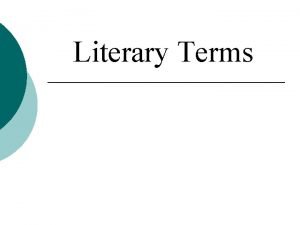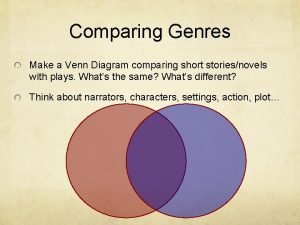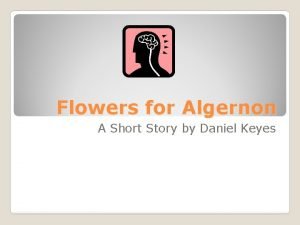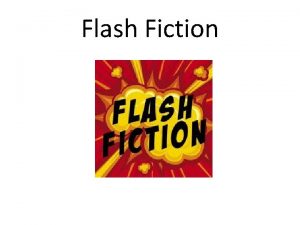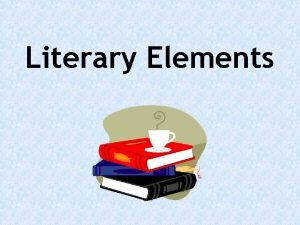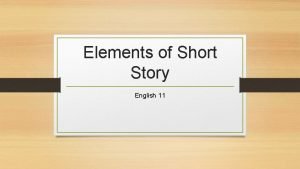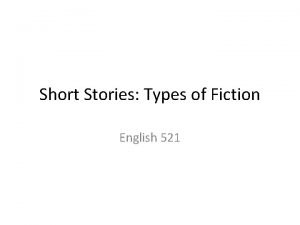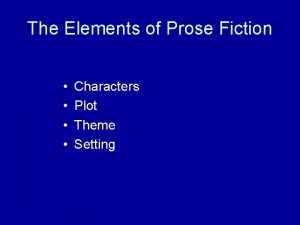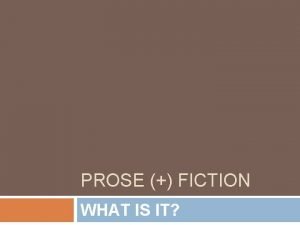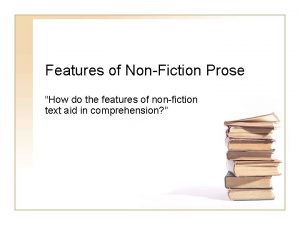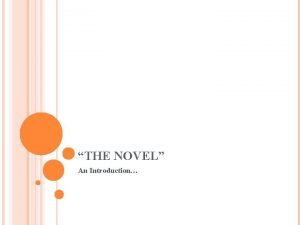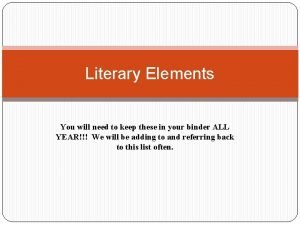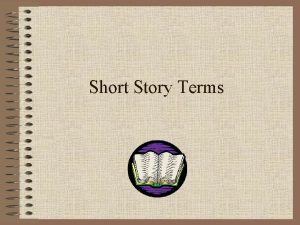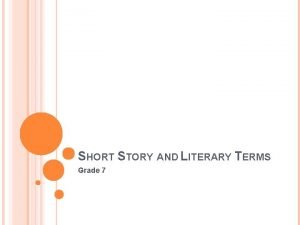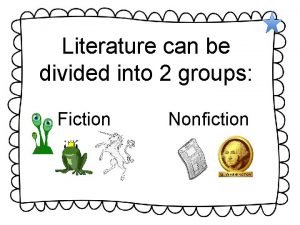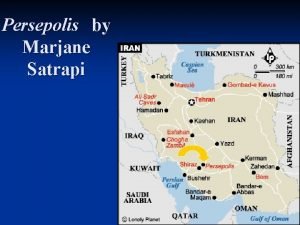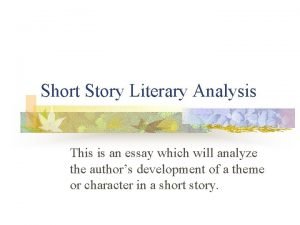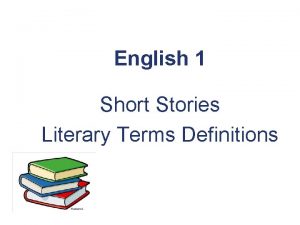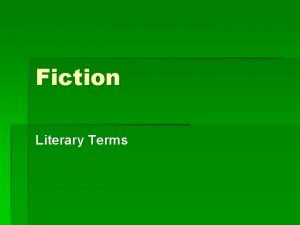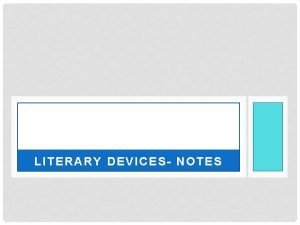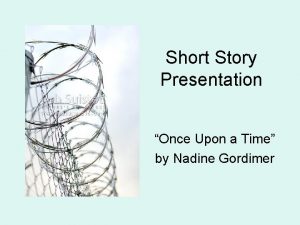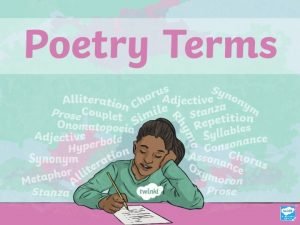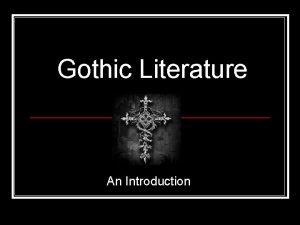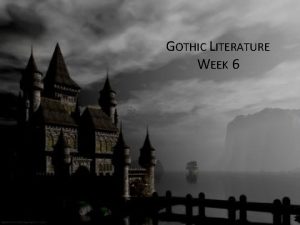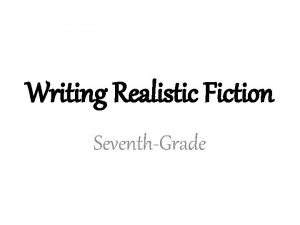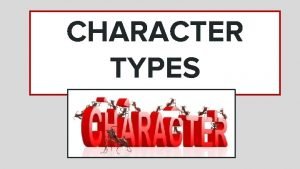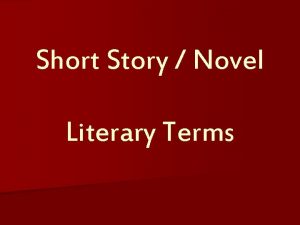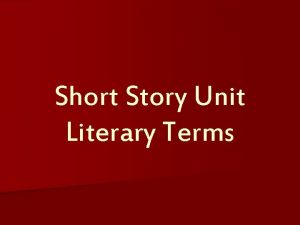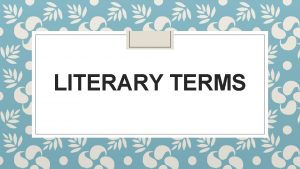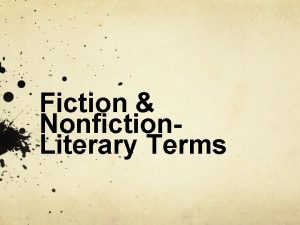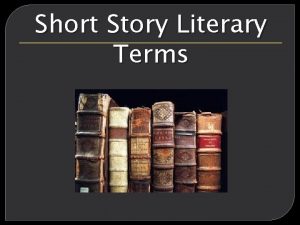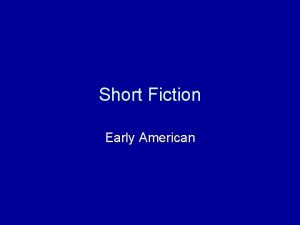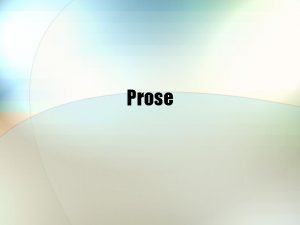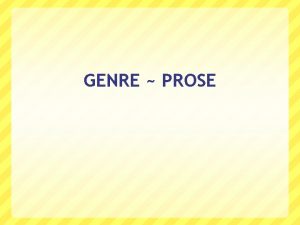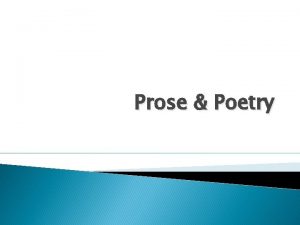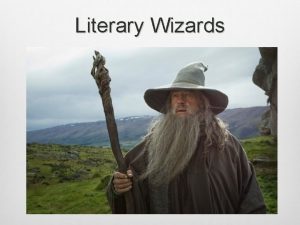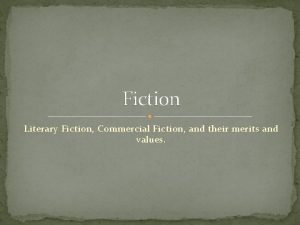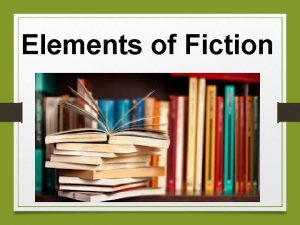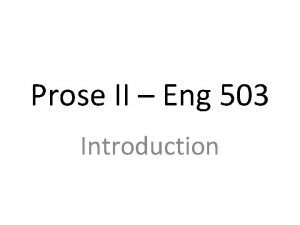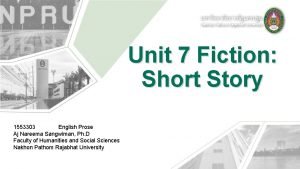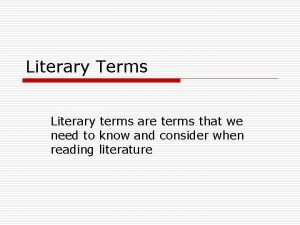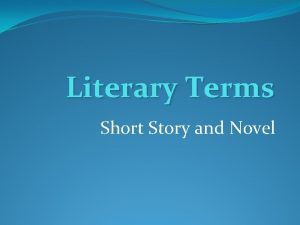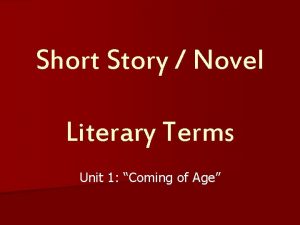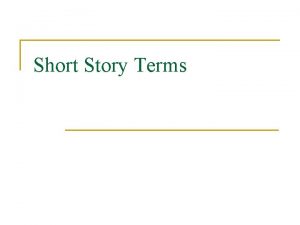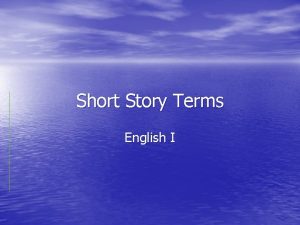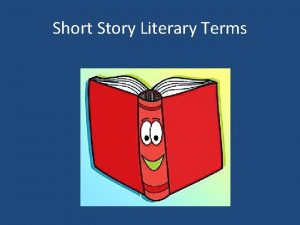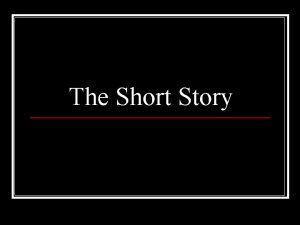Short Story Novel Literary Terms Fiction n prose





































- Slides: 37

Short Story / Novel Literary Terms

Fiction n prose writing that tells about imaginary characters and events. n Some fiction is entirely made-up, while other fiction is based on real events and/or people

Setting n Place—though usually n the time and place of physical—may also the action. involve the social, economic, or cultural environment of the n Time can include not only the story historical period—past, present, or future—but also a specific year, season, or time of day.

Protagonist nmain character in a literary work. n. He/she is NOT necessarily the “good guy”, just the main character

Antagonist na character or force in conflict with the main character n. This is NOT necessarily the “bad guy”, just the person or thing that is working against the main character

Conflict §A conflict is a struggle between opposing forces. §There are two types of conflict: INTERNAL -conflict that EXTERNAL –conflict that occurs inside the mind and outside of the character /or soul of -man Vs. man the character -man Vs. nature -man Vs. self -man Vs. society -man Vs. fate

Symbol n Something that has a literal meaning (DENOTATION), but also stands for or represents an abstract idea(CONNOTATION). Example: The American Flag– on a literal level (denotative level), it is just a flag, a piece of cloth. However, it also stands for (connotes) this particular county, for freedom, etc.

Denotation Vs. Connotation n Denotation: The dictionary meaning of a word n Connotation: The set of ideas associated with a word in addition to the word’s actual, explicit meaning

Irony n The difference between appearance and reality, expectation and result. n There are THREE kinds of Irony: 1. Verbal Irony: a word or phrase used to suggest the opposite of its actual meaning 2. Dramatic Irony: When there is a contradiction between what a character thinks and what the readers know is true

Irony (continued) 3. Situational Irony: When an event directly contradicts expectations of the reader or of the characters

Dialogue a conversation between Example: characters. After walking into the kitchen, Susie cried, n It is often used to reveal “Mom, how could you things about a eat the last cupcake? !” character’s thoughts, motivations, and Mom replied, “I was personality to the hungry, and you weren’t reader, and to advance here. It was delicious, the action of the plot. my dear!” n

Diction n Word choice, including vocabulary used, word appropriateness, and vividness of language

Mood n The feeling created in the reader by a literary work Tone n The attitude toward the subject that an author conveys in a piece of writing

Purpose n The author’s reason for writing a specific piece (Examples: To entertain, to inform, or to persuade the reader)

Foreshadowing n Clues in a literary work that suggest events that have yet to occur §This literary device helps to create suspense, keeping readers wondering about what will happen next.

Generalization n A broad principle that is supported by evidence or particulars Evidence n Particulars, or details, that lead to generalizations Evidence GENERALIZATION (BIG PICTURE!!!)

Theme n The central message or insight into life revealed through a literary work – This is the deeper meaning, the main lesson/message/moral that the author hopes the reader will understand at the end of the story

Simile n A comparison between two unlike things using “like” or “as”. n Similes are used to make descriptions of objects or people more powerful. Example: Without a simile: “It was dark outside. ” With a simile: “The night was as dark as thick, black velvet. ”

Allusion n When one literary work references a well- known person, place, event, work of art, or another literary work to make a point. Example: In Taylor Swift’s song “Love Story”, she alludes to the play “Romeo and Juliet” and the novel The Scarlet Letter to enhance her message.

Metaphor n A comparison between two unlike things, without using the words “like” or “as”. n Instead, one thing is spoken of as though it is something else completely. Example (from the Langston Hughes poem “Dreams”): “…if dreams die Life is a broken-winged bird That cannot fly”

Personification n A type of figurative language, where a non- human object is given human characteristics Examples: -The desk coughed and grunted as I shoved it across the old wooden floor. -The tea kettle whistled once the water was boiling.

Imagery n The descriptive or figurative language used in literature to create word pictures for the reader. n These word pictures/images, are created by details of sight, sound, taste, touch, smell, or movement.

Point of View n The perspective or angle from which a story is being told n There are several types: – First-Person-Point-of-View: When the narrator telling the story is one of the characters, and tells the story as a personal account – Third-Person-Point-of-View: When the narrator is not one of the characters (has no name, and does not participate in any of the action of the plot)

Point of View (continued) n There also two types of Third-Person-Point- of-View: – Third-Limited -Point-of-View: When the narrator Thirdsees the world through one character’s eyes and reveals only that character’s thoughts – Third-Omniscient -Point-of-View: When the Thirdnarrator sees into the minds of all the characters

Characterization n The way a writer reveals a character’s personality and traits n There are two methods: – Direct Characterization: The author directly states a character’s personality and/or physical traits – Indirect Characterization: Uses a character’s thoughts, actions, and feelings, to suggest the character’s traits.

Dynamic Character n A character that develops and changes through the course of a story Example: Ebenezer Scrooge at the beginning of “A Christmas Carol”, he is a mean, lonely man that is only interested in money. By the end of the story, he is generous, and interested in the “true spirit of Christmas. ”

Static Character n A character that does not change or develop through the course of the story Example: Wile E. Coyote

Round Character n A character that exhibits many traits, faults as well as virtues Flat Character n A character who seems to have only a single personality trait

Narrator n. The person from whose perspective a story is told

Fantasy n A work of fiction with characters, places, and events that could not really exist

Plot n. The sequence of events that make up a story, usually centering around a main conflict

The Five Stages of Plot

Exposition n The first stage of plot! n In the Exposition, the scene is set: – this part of the story introduces the characters, tells the reader the setting, and provides all of the necessary background information

Rising Action n The second stage of plot! n This is where the action usually begins. In the Rising Action, the conflict is introduced (either between characters, or with an outside force). This conflict will build up pressure until the Climax

Climax n The climax is the highest point of conflict in the story!! n Generally, this is the point after which everything is different. All of the pressure or events of the Rising Action have stacked up to this moment, when something must change

Falling Action n This stage begins the downward slope the conflict lessens, and the plot moves towards closure

Resolution/Denouement n In the final stage of plot, the conflict concludes, and loose ends are tied up.
 Short short short long long long short short short
Short short short long long long short short short Short story in literary terms
Short story in literary terms Short story introduction examples
Short story introduction examples Fiction and drama venn diagram
Fiction and drama venn diagram Synopsis of flowers for algernon
Synopsis of flowers for algernon A short story is similar to flash fiction because
A short story is similar to flash fiction because Elements of a short story
Elements of a short story Element of short story
Element of short story Short fiction story
Short fiction story Short fiction story
Short fiction story The elements of prose
The elements of prose Prose fiction
Prose fiction Unsur-unsur intrinsik
Unsur-unsur intrinsik Elements of narrative prose
Elements of narrative prose What is nonfiction prose
What is nonfiction prose Prose fiction
Prose fiction Prose fiction
Prose fiction Short story with flashback
Short story with flashback Elements of a novel grade 7
Elements of a novel grade 7 The genre of speculative fiction dealing with concepts
The genre of speculative fiction dealing with concepts Elements of nonfiction narrative
Elements of nonfiction narrative Contemporary realism literature
Contemporary realism literature Fiction and non fiction activities
Fiction and non fiction activities Graphic novel terms
Graphic novel terms Literary analysis example for a short story
Literary analysis example for a short story Short story literary definition
Short story literary definition The lottery theme
The lottery theme A brief work of fiction is also called a
A brief work of fiction is also called a The wind whispered through dry grass
The wind whispered through dry grass Once upon a time story by nadine gordimer
Once upon a time story by nadine gordimer Prose in literature
Prose in literature Gothic horror def
Gothic horror def Literary devices review
Literary devices review Gothic fiction definition
Gothic fiction definition Polynomial classification
Polynomial classification Like terms
Like terms Realistic fiction story ideas for 7th grade
Realistic fiction story ideas for 7th grade A character who remains the same throughout the story
A character who remains the same throughout the story

